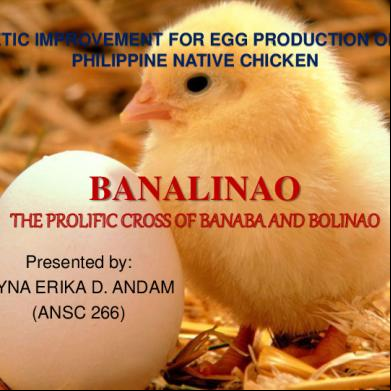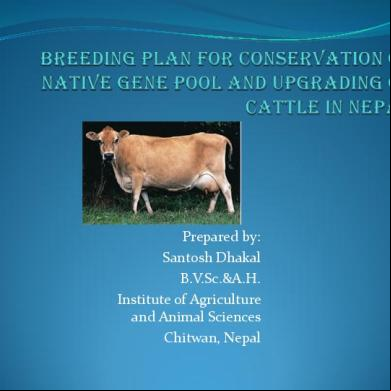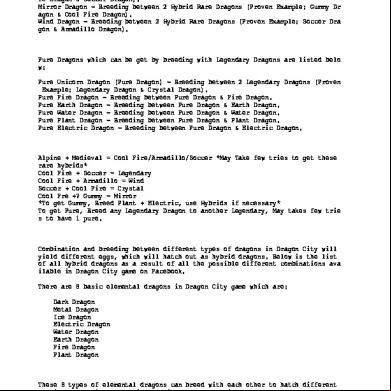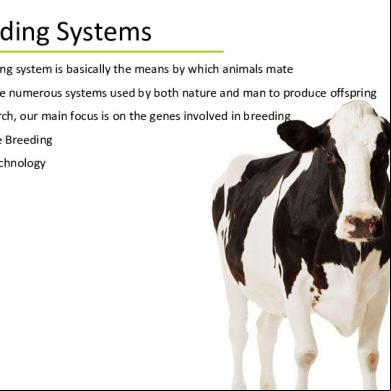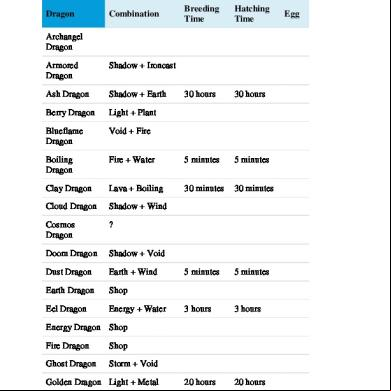Breeding Plan 3x5mi
This document was ed by and they confirmed that they have the permission to share it. If you are author or own the copyright of this book, please report to us by using this report form. Report 3b7i
Overview 3e4r5l
& View Breeding Plan as PDF for free.
More details w3441
- Words: 3,842
- Pages: 92
GENETIC IMPROVEMENT FOR EGG PRODUCTION OF THE PHILIPPINE NATIVE CHICKEN
BANALINAO THE PROLIFIC CROSS OF BANABA AND BOLINAO Presented by: DYNA ERIKA D. ANDAM (ANSC 266)
INTRODUCTION Native chicken production plays a vital role in augmenting the income of rural families. Its potential as an alternative source of food especially in sudden times of economic difficulties brought about by rather unpredictable amount of harvest has been more than proven by most families in the countryside.
The Native Chicken The native chicken present in the country originated from the Southeast Asia. Its wild ancestors is believed to be white jungle fowls with four species namely:
◦ ◦ ◦ ◦
red jungle fowl (Gallus gallus) ceylones jungle fowl (Gallus layette) gray jungle fowl (Gallus sonnerati) black or green jungle fowl (Gallus various).
Majority of the Philippine native chicken had a very strong similarity in of physical appearance with their wild ancestral type.
The male are nervous and flighty while the female has a strong maternal instinct.
Economic Importance
They are known for the characteristics of being hardy, can reproduce and survive under the local condition with a minimal care and management.
Most native chickens are raised by many smallholder farmers as additional source of food.
Through the years, the importance and economic value of native chicken in a niche market is slowly realized.
In addition to its common contribution in the form of eggs and meat, as a source of additional income to the rural farmers during lean months of the year, it is also utilized as an object for recreation in the form of cockfighting.
Many people in the urban areas are now looking at the native chicken as a source of nutritious food.
The inclination for foods which are healthy and are organically raised or grown is the present trend in the urban areas.
Their preference is now shifting from the products of the common or exotic breeds to the products coming from the native chicken (eggs or meat).
Despite of the size, native chicken is more expensive and more preferred compared with the exotic breeds because of its unique flavour or taste, leanness, pigmentation and sustainability for special dishes.
Industry Status
In 2010, the population of native chicken in the Philippines was estimated to 159 million, ing to almost half of the total population of chicken in the country (PCARRD, 2011).
With the advent of improved technology, they were able to identify and locate the different strains of the Philippine native chicken.
In 1998, PCCARD finally characterized the Philippine native chicken as the common backyard fowl, which is a mixture of different breeds.
Strains of native chickens are documented:
Banaba (Batangas) Bolinao (Pangasinan) Camarines (Bicol) Darag (Iloilo/Panay) Paraoakan (Palawan)
Candidate for Genetic Conservation To increase native chicken production, interventions and improvement of its traditional management systems were studied (Argana, 2011). (Haitook et al., 2003) many attempts have been made to improve the performance of native chicken by introducing exotic breeds for crossbreeding and to produce hybrids with
These animals were not accepted by a part of the consumers, because they did not meet their expectations for meat quality, mainly taste. The native chicken continues to be the most preferred type, with firm and lowfat meat, and free of drug residues (Choprakarn et al., 2000).
Upgrading of the native chicken to improve productive performance, and even uncontrolled mating strategies (inbreeding) may lead to genetic dilution and even loss of genetic variation within these breeds, resulting to their eventual extinction (Shresta, 2005; Scherf, et al., 2006).
Native vs. Commercial Production potential of the local birds is poor in comparison with the commercial lines It has been observed that native chickens raised under scavenging system normally produce on average 10-15 eggs about 3-4 times a year and weigh between 1-1.5 kgs at about 18 wks of age (Lambio et al. 2004).
With the improved management and nutrition, native hens can now lay as many as 130-200 eggs per year at 18-20 wks of age compared with the 40-60 eggs within the same time under the traditional management system.
For its part, a native rooster is ready for breeding at 20-24 wks of age.
Attain as much as 1 kg within 12 wks while it normally takes 18-20 wks to attain the same weight under the traditional management system (Argana, 2011).
Breeding Objective
To come up with a stable genetic trait for high egg production of the Philippine native chicken utilizing the existing indigenous chicken in the country (upon attaining the proper identification of their true genetic characteristics).
To select and improve the best performing Banaba and Bolinao breeds in of egg number produced per year and cross together to attain higher productivity. To produce the most prolific Banalinao cross which can produce 25 eggs per clutch for eight cycles per year (approximately 200 eggs/year).
Traits for Improvement
The breeding program will focus mainly on the improvement of egg number produced per clutch (per year).
In the process of improvement, number of laying (clutch) in a year (from 4-5 times to 810 times) and broodiness (decrease the number of pauses) will also be considered since these are the function of the hen’s capability to produce more egg.
In addition, sexual maturity (in a shorter period, say from 7-8 mos. to 4.5-5 mos. only), egg weight, egg size, egg quality, hatchability, and liveability are also in consideration.
Inbreeding Will be done (3 generations) to increase homozygosity and to reduce genetic variation within an inbred line. To have a concentrated population of genetically superior individual and to form inbred lines that will be used for linecrossing To exploit heterosis and to benefit from complementarity among specialized stocks (Bondoc, 2008).
Heterosis
Heterosis or hybrid vigor is the tendency of outbred strains to exceed both inbred parents in fitness.
It is strongest in first generation hybrids and gets weaker over time.
Heterosis
Most estimates of heterosis are in the 0 to 30 percent range (Bondoc, 2008).
The general combining abilities and the specific combining abilities are two of the ways to determine estimated heterosis.
General Combining Ability (GCA)
The mean performance of a line in all its crosses (expressed as a deviation from the mean of all crosses) is called the general combining ability (GCA) of the line.
It is the average value of all the F1s having this line as one parent.
In this program, it is the additive genetic effect of males from the ith line (e.g Bolinao) and females from the jth line (e.g. Banaba). Then, the offspring or cross will have an “expected” value, which is the sum of the general combining abilities of its two parental lines.
Specific Combining Ability (SCA)
It is the interaction of the additive effect of the male and female coming from their specific lines and represents all dominance, overdominance, and epistasis effects.
The effect of interaction may cause deviation in the expected value of the cross to its actual value.
It can be greater or lesser because some lines combine well (nicking) and others do not (Bondoc, 2008).
Selection of Genetic Material The genetic group of Philippine native chicken to be considered in this breeding program are the Bolinao and Banaba. These are chosen because they are excellent in the trait that is being considered for the breeding program compared to the other genetic groups of Philippine native chicken.
Breed
Maturity age(mo.)
Matured wt. (kg)
Location
Characteristics
Batangas
This breed is reported to be resistant to respiratory diseases and fowl pox. The hens are broody and excellent mothers, it is very hard to break its broodiness. The breed is very popular as game in the Philippines.
35
The meat is very tasty. The hens are broody and excellent mothers. This breed is popularly raised by Pangasinan farmers for its aggressiveness in fighting. The animals are brave warriors.
35
BANABA Male
Female
6
5.5
1.6
1.5
BOLINAO Male
Female
6
5.5
2
1.5
Table 1. General characterization of Bolinao and Banaba native chicken. Source: DAD-IS FAO, 2012
Ave. Egg prod/yr
BANABA
BOLINAO
BREEDING SYSTEMS AND ACTIVITIES
SOURCING AND SELECTION OF FOUNDATION STOCKS
The foundation stocks will be obtained from various municipalities of Batangas (Banaba) and Pangasinan (Bolinao).
To reiterate, the stocks that will be selected should have been undergone, phenotypic and genotypic characterization by the Project on Phenotypic and molecular characterization of the Philippine native chicken.
Stage 1: Procurement of Foundation Stocks
500 pullets and 100 roosters will be selected and procured. ◦ 250 banaba pullet and 50 rooster ◦ 250 bolinao pullet and 50 rooster
The selected stocks will be the Great Grand Parent Stocks (GGPS) Will be grouped into 100 families (50 for each breed)
Stage 2: Selection and Backcrossing
Production and Selection of F1
250 ready-to-lay pullets (total of 500) will be mated naturally (random mating) to 50 ready-to-breed roosters (total of 100) 1:5 male to female ratio to produce the F1 stocks.
The F1 eggs (GPS) will be identified and hatched.
Fertility and hatchability of each mating will be recorded.
At hatching time, the chicks will be wing banded and parents will be noted. Day old chick that weighs less than 25g will be culled, this would be based on the average weight of day old chicks of Banaba (25g) (Lambio et. al., 2000). The chicks coming from the clutch of ≥21 will be selected; the rest will be culled.
Individual egg production of the hens will be recorded which includes number of egg produced up to 40th week of age, fertility and hatchability of eggs.
Those hens whose hen-day egg production below 28% will be culled.
Production of the F2 - F4
250 ready-to-lay pullets will be selected from the F1 Will be then mated naturally to 50 GGPS roosters
1:5 male to female ratio
3 generations of back crossing will be done to attain the positive effect of inbreeding. For each generation, the intensity pressure of selection for egg number will also be increased.
The chicks coming from the clutch of ≥22 will be selected (for the F2)
For the next generation (F3-F4) ≥23 and ≥24 will be the basis for selection; the rest will be culled.
Individual egg production of the hens will be recorded which includes number of egg produced up to 40th wk of age, fertility and hatchability of eggs.
For genetic improvement, those hens whose hen-day egg production below 32% will be culled.
Stage 3: Production and Crossing of the Purelines
Six line groups will be established (3 for each breed) out of the F4 stocks.
Each line group will be grouped into 20 families with 100 females and 20 males, this time to avoid inbreeding.
A total of 600 selected females and 120 selected males will be maintained.
From the F4 stocks (Parental stocks PS), selected ready-to-lay pullets and ready-to-breed roosters from Bolinao and Banaba will be crossed to obtain the F5 crossbreds ( F1 of the PS).
2 generations of inter se mating will be done to identify the best combination of lines that will produce the most prolific cross, Banalinao. For the F7, the best Banalinao (female) coming from the most appropriate cross will be selected. The basis for selection would be ≥25 eggs/clutch for 8-10 cycles/yr, sexual maturity of 4.5-5 mos.
Stage 4: On site Performance testing Production/Multiplication of the resulting cross will be done The PS (improved Banaba rooster and Bolinao hen) will be distributed to the willing raisers/co-operators in the several provinces of Luzon (targeting Ilocos Norte, Pangasinan, Aurora, Quezon and Batangas)
1
2 3
4
5
Distribution of PS
They will be the multiplier farm of Banalinao chicks.
5 cooperators from each province (total of 20 cooperators) will be selected.
Each farm cooperator will be provided with 2 roosters and 5 hens.
Distribution of Banalinao chicks Distribution of the produced genetically improved Banalinao cross will be done with the willing raisers in Luzon (Batangas, Pangasinan, Aurora, Ilocos Norte, Quezon). 10 cooperators from each province (total of 50 cooperators) will also be selected.
They will be the egg producer (layer farm). Each farmer co-operator will be provided with 20 hens. A memorandum of agreement (MOA) will be established with the cooperators
◦ Only the stocks will be given to them but they have to allow the project personnel to gather data for evaluation on the on-site performance of the native chicken.
These cooperators will undergo training-workshop regarding the needs of the on-site performance testing prior to the start of the testing.
Mating Diagram of Family 1 (Backcrossing) Rooster A Rooster A Rooster A Rooster A
Hen AB
Hen ABA
Hen ABAA
Hen 4AB
Hen B
F2 F3
F4
F1
Mating Diagram of Family 2 (Backcrossing) Rooster C Rooster C Rooster C Rooster C
Rooster 4CD
Hen D Hen CDC
Hen CDC
Hen CDCC
F2 F3
F4
F1
Mating Diagram (Banaba-Bolinao crossing)
Rooster Ba1
Male Babo1
Hen Bo1
Female Babo1
F 4
Rooster Bo2
F5
Male Boba2
Hen Ba2
Female Boba2
TWO GENERATIONS OF INTERSE MATING (F6-F7)
BANALINAO
Methods of Selection
The method of selection based on record that will be used is the combination of individual and family selection.
For the parent hens, they will be selected based on the number of eggs they will lay and hatch.
For the parent roosters, they will be selected based on their own performance (BW and conformation) as well as on the performance of their female siblings.
For the male offspring, they will be selected based on the performance of their parents (e.g. if they came from a hen which can lay 21 eggs/clutch), on the performance of their female siblings, and on their own performance (BW).
Independent culling level method will be used for the selection procedure.
There is a minimum standard set for an animal to be saved for breeding purposes.
For this project the goal is to increase egg number and maintaining a certain body weight at sexual maturity (4.5-
Assumptions
F1, ≥ 21 eggs/clutch with 1.3 kg body weight at sexual maturity (4.5-5mos).
F2, ≥ 22 eggs/clutch with 1.3 kg body weight at sexual maturity.
F3 and F4, ≥ 23 and ≥ 24 eggs/clutch with 1.3 kg body weight at sexual maturity, respectively.
F5 ≥ 25 eggs/clutch with 1.3 kg body weight at sexual maturity. The predetermined level on the 5th generation (≥ 25 eggs/clutch and with 1.3 kg body weight at sexual maturity) will be maintained for the 6th until 7th generation.
COMPUTATIONS
Estimated Genetic Change (EGC)
gi = (generation interval) In poultry, generation interval is 8-12 months (Lopez, 2012). H = (heritability) estimates of egg production traits varies from 0.17 ± 0.01 to 0.43 ± 0.01. In this project, assumption for heritability is equal to 0.20 (20%)
SD = (selection differential) it is the difference between the performance on a particular trait of the selected individuals and the average performance of the flock.
Assumptions on EN of F1 F1
EN in a clutch
ROOSTER (selected animals)
21
HEN (selected animals)
21
FLOCK AVERAGE
18
Solutions: SD = 21 eggs- 18 eggs = 3 eggs H*SD = 0.20 x 3 eggs = 0.6 Genetic Contribution (rooster) = 0.6/2 = 0.30 Genetic Contribution (hen) = 0.6/2 = 0.30
∆G = (0.3+0.3)/1 ∆G = 0.6
Both parents would contribute only half to the genetic materials to be ed on to the next generation.
Genetic change for the number of cycle (number of clutch in a year), sexual maturity, hatchability etc. will also be done in the same manner as the previous computations to determine of these traits.
MANAGEMENT PRACTICES
Identification of the Stocks Metal leg bands with different colors will be used to identify the selected breeders. The breeding rooster will have a red leg band with letters at the end The hens will have different colors (e.g. blue, yellow and green) and numbers. This will facilitate identification and recording and will also serve as a guide
Record Keeping
Proper record keeping management will be employed to accurately identify the selected breeders. This will help keep tract on specific individuals and mating performance. Production performance of the animals will be recorded to determine improvements of the flock.
Production System for Breeder Stocks
Semi-confinement production system will be applied for the Breeder.
Similarly, the intention of this program is to develop an improved Banaba and Bolinao as well as to produce a cross that would perform best in this type of production system.
Housing Management Provided with a holding shed that is elevated and situated in a well drained area. Floor space allowance of 0.5 m2/bird Made of low-cost and locally available materials such as nipa (for roofing), wood (poles, thrushes, and beam), bamboo (for flooring) and buho (for side enclosures). All sheds or houses will be provided with sufficient feeders (6.5cm/bird) and
Management of Breeder Stocks A 1:5 rooster to hen ratio will be maintained and will be considered as one family unit. This ratio is done to achieve optimum fertility in hatching eggs and to be able to monitor family productivity. Nest boxes or baskets made from locally available will be made available when the hens start to lay eggs at 18 weeks of age
Management of Breeder Stocks Appropriate litter material will be placed in the nest boxes and will serve as nest of the laying hen. Fresh leaves of lemongrass will also be placed in the nest boxes to inhibit mites, ticks, and insects proliferating in the nests. Perches will be installed in the upper portion of the houses except in the places where the direction of feeding and watering troughs are located to avoid
Feeding Management The breeder hen will be provided with commercial poultry ration, corn, palay, or other available feed materials or in a mixture of these materials. Approximately 50g of feed will be provided to each breeder hen per day. The amount of feed may be adjusted depending on the availability of naturally occurring feed materials present in the area. The birds will be provided with fresh drinking water at all times.
Health Management Utilization of ethnoveterinary medication and practices. The breeder stocks will be dewormed at 17 weeks old (before laying) with the use of Quisqualis indica (Yesterday, Today, and Tomorrow). As a supplement, honey will be provided in the drinking water for three consecutive days in a week at a dosage of one teaspoon for every gallon of drinking
Production system for Day-old and Growing Chickens HOUSING MANAGEMENT The construction of a brooder house will consider the comfort and protection of the chicks. The ease of management and movement of the caretakers will also be considered.
Housing Management
The housing will be made from locally available materials such as bamboos, nipa, wood poles and mesh wires.
Roll-up-roll-down curtains along the sides of the brooder house will be installed to protect the chicks form increment weather conditions.
Brooding Management ●A brooder box will be constructed.
●The day-old chicks will be placed in these brooder boxes up to 21 days of age where they will be kept warmed with incandescent bulb according to the temperature required for their stage of growth.
Brooding Management Table 3. Brooder temperature for the various ages of the chicks.
Age (days)
Brooder Temperature (oC)
1-7
32.2 – 35.0
8-14
29.4 – 32.2
14-21
26.7 – 29.4
Feeding Management
The chicks will be provided with commercial chick ration or a mixture of corn, rice bran, soybean, meal or other available feed materials.
When the chicks are 21-days old, they will be hardened by gradually introducing them to range conditions by letting them loose in the field until 45 days.
Feeding Management
The chicks are trained to search for food by spreading their ration in different locations within the fenced range area. The ranging area will be increased during growing period.
The birds will be provided with fresh drinking water at all times. Bamboo poles or used tires (split in half) will be used as feeders and waterers.
Table 4. Type of feed, amount to be given and number of days to give the feed for particular age of the chicks. Age (wks)
% Feed Type
Amt. To be given
0–2
22
Booster
10
2–4
20
Starter
20
4–6
18
Grower 1
50
6 – 12
17
Grower 2
50
12 -18
15
Finisher
50
Feeding period
45
81
Health Management ●Quisqualis indica will be also used to deworm the birds on a monthly basis. ●Leaves of this plant will be decocted and provided in the water at a rate of 10 ml per bird. ●Just like the breeders, honey will be supplemented and ethnoveterinary medication will be implemented.
PROJECT IMPLEMENTATION The first three stages of the breeding program will be done here in the University of the Philippines Los Baǹos, Laguna. The university will provide the use of existing facilities, technical and staff for the implementation of the project.
The fund allocation will include construction of the poultry houses and fencing, transport vehicle, incubators, tools and equipments, labours, feeds, and other farm supplies for the maintenance of the stocks
Unselected and culled birds will be sold and the income will be utilized for the continuity of the project and improvement of the facilities. All the data gathered from all phases of the breeding program will be used as bases for the promotion and marketing strategies as well as commercialization of the final product of this project.
The stage 4 of the breeding program will be undertaken at 75 selected farmer-cooperators from the chosen provinces. The project will only provide the stocks to the co-operators while the cooperator will shoulder the expenses needed for the performance testing such as food, shelter, water etc.
INITIAL COSTS Cost of stocks Breeder hen Breeder rooster Total Feed Costs Construction of poultry house (Labor) Direct Labor Initial housing costs Utility expenditure (electricity and water) Farm Tools and Equipment Incubator (1,500 capacity)
Php 100,000 20,000 9,600 5,600 12,000 60,000 600 10,000 50,000
INITIAL COSTS Costs of Biologics and Medicine Repair and Maintenance Cost Sundries
480 3,000 290
TOTAL INITIAL CAPITAL 271,570.00
TARGET MARKET
Niche Market
Grocery stores ◦ Could possibly displayed beside the commercial chicken products (eggs)
BANALINAO CROSS
THANK YOU!!!!
BANALINAO THE PROLIFIC CROSS OF BANABA AND BOLINAO Presented by: DYNA ERIKA D. ANDAM (ANSC 266)
INTRODUCTION Native chicken production plays a vital role in augmenting the income of rural families. Its potential as an alternative source of food especially in sudden times of economic difficulties brought about by rather unpredictable amount of harvest has been more than proven by most families in the countryside.
The Native Chicken The native chicken present in the country originated from the Southeast Asia. Its wild ancestors is believed to be white jungle fowls with four species namely:
◦ ◦ ◦ ◦
red jungle fowl (Gallus gallus) ceylones jungle fowl (Gallus layette) gray jungle fowl (Gallus sonnerati) black or green jungle fowl (Gallus various).
Majority of the Philippine native chicken had a very strong similarity in of physical appearance with their wild ancestral type.
The male are nervous and flighty while the female has a strong maternal instinct.
Economic Importance
They are known for the characteristics of being hardy, can reproduce and survive under the local condition with a minimal care and management.
Most native chickens are raised by many smallholder farmers as additional source of food.
Through the years, the importance and economic value of native chicken in a niche market is slowly realized.
In addition to its common contribution in the form of eggs and meat, as a source of additional income to the rural farmers during lean months of the year, it is also utilized as an object for recreation in the form of cockfighting.
Many people in the urban areas are now looking at the native chicken as a source of nutritious food.
The inclination for foods which are healthy and are organically raised or grown is the present trend in the urban areas.
Their preference is now shifting from the products of the common or exotic breeds to the products coming from the native chicken (eggs or meat).
Despite of the size, native chicken is more expensive and more preferred compared with the exotic breeds because of its unique flavour or taste, leanness, pigmentation and sustainability for special dishes.
Industry Status
In 2010, the population of native chicken in the Philippines was estimated to 159 million, ing to almost half of the total population of chicken in the country (PCARRD, 2011).
With the advent of improved technology, they were able to identify and locate the different strains of the Philippine native chicken.
In 1998, PCCARD finally characterized the Philippine native chicken as the common backyard fowl, which is a mixture of different breeds.
Strains of native chickens are documented:
Banaba (Batangas) Bolinao (Pangasinan) Camarines (Bicol) Darag (Iloilo/Panay) Paraoakan (Palawan)
Candidate for Genetic Conservation To increase native chicken production, interventions and improvement of its traditional management systems were studied (Argana, 2011). (Haitook et al., 2003) many attempts have been made to improve the performance of native chicken by introducing exotic breeds for crossbreeding and to produce hybrids with
These animals were not accepted by a part of the consumers, because they did not meet their expectations for meat quality, mainly taste. The native chicken continues to be the most preferred type, with firm and lowfat meat, and free of drug residues (Choprakarn et al., 2000).
Upgrading of the native chicken to improve productive performance, and even uncontrolled mating strategies (inbreeding) may lead to genetic dilution and even loss of genetic variation within these breeds, resulting to their eventual extinction (Shresta, 2005; Scherf, et al., 2006).
Native vs. Commercial Production potential of the local birds is poor in comparison with the commercial lines It has been observed that native chickens raised under scavenging system normally produce on average 10-15 eggs about 3-4 times a year and weigh between 1-1.5 kgs at about 18 wks of age (Lambio et al. 2004).
With the improved management and nutrition, native hens can now lay as many as 130-200 eggs per year at 18-20 wks of age compared with the 40-60 eggs within the same time under the traditional management system.
For its part, a native rooster is ready for breeding at 20-24 wks of age.
Attain as much as 1 kg within 12 wks while it normally takes 18-20 wks to attain the same weight under the traditional management system (Argana, 2011).
Breeding Objective
To come up with a stable genetic trait for high egg production of the Philippine native chicken utilizing the existing indigenous chicken in the country (upon attaining the proper identification of their true genetic characteristics).
To select and improve the best performing Banaba and Bolinao breeds in of egg number produced per year and cross together to attain higher productivity. To produce the most prolific Banalinao cross which can produce 25 eggs per clutch for eight cycles per year (approximately 200 eggs/year).
Traits for Improvement
The breeding program will focus mainly on the improvement of egg number produced per clutch (per year).
In the process of improvement, number of laying (clutch) in a year (from 4-5 times to 810 times) and broodiness (decrease the number of pauses) will also be considered since these are the function of the hen’s capability to produce more egg.
In addition, sexual maturity (in a shorter period, say from 7-8 mos. to 4.5-5 mos. only), egg weight, egg size, egg quality, hatchability, and liveability are also in consideration.
Inbreeding Will be done (3 generations) to increase homozygosity and to reduce genetic variation within an inbred line. To have a concentrated population of genetically superior individual and to form inbred lines that will be used for linecrossing To exploit heterosis and to benefit from complementarity among specialized stocks (Bondoc, 2008).
Heterosis
Heterosis or hybrid vigor is the tendency of outbred strains to exceed both inbred parents in fitness.
It is strongest in first generation hybrids and gets weaker over time.
Heterosis
Most estimates of heterosis are in the 0 to 30 percent range (Bondoc, 2008).
The general combining abilities and the specific combining abilities are two of the ways to determine estimated heterosis.
General Combining Ability (GCA)
The mean performance of a line in all its crosses (expressed as a deviation from the mean of all crosses) is called the general combining ability (GCA) of the line.
It is the average value of all the F1s having this line as one parent.
In this program, it is the additive genetic effect of males from the ith line (e.g Bolinao) and females from the jth line (e.g. Banaba). Then, the offspring or cross will have an “expected” value, which is the sum of the general combining abilities of its two parental lines.
Specific Combining Ability (SCA)
It is the interaction of the additive effect of the male and female coming from their specific lines and represents all dominance, overdominance, and epistasis effects.
The effect of interaction may cause deviation in the expected value of the cross to its actual value.
It can be greater or lesser because some lines combine well (nicking) and others do not (Bondoc, 2008).
Selection of Genetic Material The genetic group of Philippine native chicken to be considered in this breeding program are the Bolinao and Banaba. These are chosen because they are excellent in the trait that is being considered for the breeding program compared to the other genetic groups of Philippine native chicken.
Breed
Maturity age(mo.)
Matured wt. (kg)
Location
Characteristics
Batangas
This breed is reported to be resistant to respiratory diseases and fowl pox. The hens are broody and excellent mothers, it is very hard to break its broodiness. The breed is very popular as game in the Philippines.
35
The meat is very tasty. The hens are broody and excellent mothers. This breed is popularly raised by Pangasinan farmers for its aggressiveness in fighting. The animals are brave warriors.
35
BANABA Male
Female
6
5.5
1.6
1.5
BOLINAO Male
Female
6
5.5
2
1.5
Table 1. General characterization of Bolinao and Banaba native chicken. Source: DAD-IS FAO, 2012
Ave. Egg prod/yr
BANABA
BOLINAO
BREEDING SYSTEMS AND ACTIVITIES
SOURCING AND SELECTION OF FOUNDATION STOCKS
The foundation stocks will be obtained from various municipalities of Batangas (Banaba) and Pangasinan (Bolinao).
To reiterate, the stocks that will be selected should have been undergone, phenotypic and genotypic characterization by the Project on Phenotypic and molecular characterization of the Philippine native chicken.
Stage 1: Procurement of Foundation Stocks
500 pullets and 100 roosters will be selected and procured. ◦ 250 banaba pullet and 50 rooster ◦ 250 bolinao pullet and 50 rooster
The selected stocks will be the Great Grand Parent Stocks (GGPS) Will be grouped into 100 families (50 for each breed)
Stage 2: Selection and Backcrossing
Production and Selection of F1
250 ready-to-lay pullets (total of 500) will be mated naturally (random mating) to 50 ready-to-breed roosters (total of 100) 1:5 male to female ratio to produce the F1 stocks.
The F1 eggs (GPS) will be identified and hatched.
Fertility and hatchability of each mating will be recorded.
At hatching time, the chicks will be wing banded and parents will be noted. Day old chick that weighs less than 25g will be culled, this would be based on the average weight of day old chicks of Banaba (25g) (Lambio et. al., 2000). The chicks coming from the clutch of ≥21 will be selected; the rest will be culled.
Individual egg production of the hens will be recorded which includes number of egg produced up to 40th week of age, fertility and hatchability of eggs.
Those hens whose hen-day egg production below 28% will be culled.
Production of the F2 - F4
250 ready-to-lay pullets will be selected from the F1 Will be then mated naturally to 50 GGPS roosters
1:5 male to female ratio
3 generations of back crossing will be done to attain the positive effect of inbreeding. For each generation, the intensity pressure of selection for egg number will also be increased.
The chicks coming from the clutch of ≥22 will be selected (for the F2)
For the next generation (F3-F4) ≥23 and ≥24 will be the basis for selection; the rest will be culled.
Individual egg production of the hens will be recorded which includes number of egg produced up to 40th wk of age, fertility and hatchability of eggs.
For genetic improvement, those hens whose hen-day egg production below 32% will be culled.
Stage 3: Production and Crossing of the Purelines
Six line groups will be established (3 for each breed) out of the F4 stocks.
Each line group will be grouped into 20 families with 100 females and 20 males, this time to avoid inbreeding.
A total of 600 selected females and 120 selected males will be maintained.
From the F4 stocks (Parental stocks PS), selected ready-to-lay pullets and ready-to-breed roosters from Bolinao and Banaba will be crossed to obtain the F5 crossbreds ( F1 of the PS).
2 generations of inter se mating will be done to identify the best combination of lines that will produce the most prolific cross, Banalinao. For the F7, the best Banalinao (female) coming from the most appropriate cross will be selected. The basis for selection would be ≥25 eggs/clutch for 8-10 cycles/yr, sexual maturity of 4.5-5 mos.
Stage 4: On site Performance testing Production/Multiplication of the resulting cross will be done The PS (improved Banaba rooster and Bolinao hen) will be distributed to the willing raisers/co-operators in the several provinces of Luzon (targeting Ilocos Norte, Pangasinan, Aurora, Quezon and Batangas)
1
2 3
4
5
Distribution of PS
They will be the multiplier farm of Banalinao chicks.
5 cooperators from each province (total of 20 cooperators) will be selected.
Each farm cooperator will be provided with 2 roosters and 5 hens.
Distribution of Banalinao chicks Distribution of the produced genetically improved Banalinao cross will be done with the willing raisers in Luzon (Batangas, Pangasinan, Aurora, Ilocos Norte, Quezon). 10 cooperators from each province (total of 50 cooperators) will also be selected.
They will be the egg producer (layer farm). Each farmer co-operator will be provided with 20 hens. A memorandum of agreement (MOA) will be established with the cooperators
◦ Only the stocks will be given to them but they have to allow the project personnel to gather data for evaluation on the on-site performance of the native chicken.
These cooperators will undergo training-workshop regarding the needs of the on-site performance testing prior to the start of the testing.
Mating Diagram of Family 1 (Backcrossing) Rooster A Rooster A Rooster A Rooster A
Hen AB
Hen ABA
Hen ABAA
Hen 4AB
Hen B
F2 F3
F4
F1
Mating Diagram of Family 2 (Backcrossing) Rooster C Rooster C Rooster C Rooster C
Rooster 4CD
Hen D Hen CDC
Hen CDC
Hen CDCC
F2 F3
F4
F1
Mating Diagram (Banaba-Bolinao crossing)
Rooster Ba1
Male Babo1
Hen Bo1
Female Babo1
F 4
Rooster Bo2
F5
Male Boba2
Hen Ba2
Female Boba2
TWO GENERATIONS OF INTERSE MATING (F6-F7)
BANALINAO
Methods of Selection
The method of selection based on record that will be used is the combination of individual and family selection.
For the parent hens, they will be selected based on the number of eggs they will lay and hatch.
For the parent roosters, they will be selected based on their own performance (BW and conformation) as well as on the performance of their female siblings.
For the male offspring, they will be selected based on the performance of their parents (e.g. if they came from a hen which can lay 21 eggs/clutch), on the performance of their female siblings, and on their own performance (BW).
Independent culling level method will be used for the selection procedure.
There is a minimum standard set for an animal to be saved for breeding purposes.
For this project the goal is to increase egg number and maintaining a certain body weight at sexual maturity (4.5-
Assumptions
F1, ≥ 21 eggs/clutch with 1.3 kg body weight at sexual maturity (4.5-5mos).
F2, ≥ 22 eggs/clutch with 1.3 kg body weight at sexual maturity.
F3 and F4, ≥ 23 and ≥ 24 eggs/clutch with 1.3 kg body weight at sexual maturity, respectively.
F5 ≥ 25 eggs/clutch with 1.3 kg body weight at sexual maturity. The predetermined level on the 5th generation (≥ 25 eggs/clutch and with 1.3 kg body weight at sexual maturity) will be maintained for the 6th until 7th generation.
COMPUTATIONS
Estimated Genetic Change (EGC)
gi = (generation interval) In poultry, generation interval is 8-12 months (Lopez, 2012). H = (heritability) estimates of egg production traits varies from 0.17 ± 0.01 to 0.43 ± 0.01. In this project, assumption for heritability is equal to 0.20 (20%)
SD = (selection differential) it is the difference between the performance on a particular trait of the selected individuals and the average performance of the flock.
Assumptions on EN of F1 F1
EN in a clutch
ROOSTER (selected animals)
21
HEN (selected animals)
21
FLOCK AVERAGE
18
Solutions: SD = 21 eggs- 18 eggs = 3 eggs H*SD = 0.20 x 3 eggs = 0.6 Genetic Contribution (rooster) = 0.6/2 = 0.30 Genetic Contribution (hen) = 0.6/2 = 0.30
∆G = (0.3+0.3)/1 ∆G = 0.6
Both parents would contribute only half to the genetic materials to be ed on to the next generation.
Genetic change for the number of cycle (number of clutch in a year), sexual maturity, hatchability etc. will also be done in the same manner as the previous computations to determine of these traits.
MANAGEMENT PRACTICES
Identification of the Stocks Metal leg bands with different colors will be used to identify the selected breeders. The breeding rooster will have a red leg band with letters at the end The hens will have different colors (e.g. blue, yellow and green) and numbers. This will facilitate identification and recording and will also serve as a guide
Record Keeping
Proper record keeping management will be employed to accurately identify the selected breeders. This will help keep tract on specific individuals and mating performance. Production performance of the animals will be recorded to determine improvements of the flock.
Production System for Breeder Stocks
Semi-confinement production system will be applied for the Breeder.
Similarly, the intention of this program is to develop an improved Banaba and Bolinao as well as to produce a cross that would perform best in this type of production system.
Housing Management Provided with a holding shed that is elevated and situated in a well drained area. Floor space allowance of 0.5 m2/bird Made of low-cost and locally available materials such as nipa (for roofing), wood (poles, thrushes, and beam), bamboo (for flooring) and buho (for side enclosures). All sheds or houses will be provided with sufficient feeders (6.5cm/bird) and
Management of Breeder Stocks A 1:5 rooster to hen ratio will be maintained and will be considered as one family unit. This ratio is done to achieve optimum fertility in hatching eggs and to be able to monitor family productivity. Nest boxes or baskets made from locally available will be made available when the hens start to lay eggs at 18 weeks of age
Management of Breeder Stocks Appropriate litter material will be placed in the nest boxes and will serve as nest of the laying hen. Fresh leaves of lemongrass will also be placed in the nest boxes to inhibit mites, ticks, and insects proliferating in the nests. Perches will be installed in the upper portion of the houses except in the places where the direction of feeding and watering troughs are located to avoid
Feeding Management The breeder hen will be provided with commercial poultry ration, corn, palay, or other available feed materials or in a mixture of these materials. Approximately 50g of feed will be provided to each breeder hen per day. The amount of feed may be adjusted depending on the availability of naturally occurring feed materials present in the area. The birds will be provided with fresh drinking water at all times.
Health Management Utilization of ethnoveterinary medication and practices. The breeder stocks will be dewormed at 17 weeks old (before laying) with the use of Quisqualis indica (Yesterday, Today, and Tomorrow). As a supplement, honey will be provided in the drinking water for three consecutive days in a week at a dosage of one teaspoon for every gallon of drinking
Production system for Day-old and Growing Chickens HOUSING MANAGEMENT The construction of a brooder house will consider the comfort and protection of the chicks. The ease of management and movement of the caretakers will also be considered.
Housing Management
The housing will be made from locally available materials such as bamboos, nipa, wood poles and mesh wires.
Roll-up-roll-down curtains along the sides of the brooder house will be installed to protect the chicks form increment weather conditions.
Brooding Management ●A brooder box will be constructed.
●The day-old chicks will be placed in these brooder boxes up to 21 days of age where they will be kept warmed with incandescent bulb according to the temperature required for their stage of growth.
Brooding Management Table 3. Brooder temperature for the various ages of the chicks.
Age (days)
Brooder Temperature (oC)
1-7
32.2 – 35.0
8-14
29.4 – 32.2
14-21
26.7 – 29.4
Feeding Management
The chicks will be provided with commercial chick ration or a mixture of corn, rice bran, soybean, meal or other available feed materials.
When the chicks are 21-days old, they will be hardened by gradually introducing them to range conditions by letting them loose in the field until 45 days.
Feeding Management
The chicks are trained to search for food by spreading their ration in different locations within the fenced range area. The ranging area will be increased during growing period.
The birds will be provided with fresh drinking water at all times. Bamboo poles or used tires (split in half) will be used as feeders and waterers.
Table 4. Type of feed, amount to be given and number of days to give the feed for particular age of the chicks. Age (wks)
% Feed Type
Amt. To be given
0–2
22
Booster
10
2–4
20
Starter
20
4–6
18
Grower 1
50
6 – 12
17
Grower 2
50
12 -18
15
Finisher
50
Feeding period
45
81
Health Management ●Quisqualis indica will be also used to deworm the birds on a monthly basis. ●Leaves of this plant will be decocted and provided in the water at a rate of 10 ml per bird. ●Just like the breeders, honey will be supplemented and ethnoveterinary medication will be implemented.
PROJECT IMPLEMENTATION The first three stages of the breeding program will be done here in the University of the Philippines Los Baǹos, Laguna. The university will provide the use of existing facilities, technical and staff for the implementation of the project.
The fund allocation will include construction of the poultry houses and fencing, transport vehicle, incubators, tools and equipments, labours, feeds, and other farm supplies for the maintenance of the stocks
Unselected and culled birds will be sold and the income will be utilized for the continuity of the project and improvement of the facilities. All the data gathered from all phases of the breeding program will be used as bases for the promotion and marketing strategies as well as commercialization of the final product of this project.
The stage 4 of the breeding program will be undertaken at 75 selected farmer-cooperators from the chosen provinces. The project will only provide the stocks to the co-operators while the cooperator will shoulder the expenses needed for the performance testing such as food, shelter, water etc.
INITIAL COSTS Cost of stocks Breeder hen Breeder rooster Total Feed Costs Construction of poultry house (Labor) Direct Labor Initial housing costs Utility expenditure (electricity and water) Farm Tools and Equipment Incubator (1,500 capacity)
Php 100,000 20,000 9,600 5,600 12,000 60,000 600 10,000 50,000
INITIAL COSTS Costs of Biologics and Medicine Repair and Maintenance Cost Sundries
480 3,000 290
TOTAL INITIAL CAPITAL 271,570.00
TARGET MARKET
Niche Market
Grocery stores ◦ Could possibly displayed beside the commercial chicken products (eggs)
BANALINAO CROSS
THANK YOU!!!!
